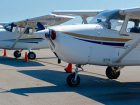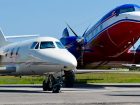
News
Expanding its key enabler role
Building and delivering on its role as a community leader. Servicing the developing corporate market. Providing a safe, functional location for flight training and the development of future pilots, engineers and other aviation professionals. Acting as a Canadian sales and service hub for a variety of key aircraft parts suppliers and valued aircraft brands.
August 28, 2017 By Matt Nicholls
Ask Oshawa Executive Airport (OEA) manager Stephen Wilcox to pinpoint precisely what he feels his airport’s specific area of expertise is and the answer is straightforward, despite the airport’s eclectic mix of businesses and services.
“Airports are seldom the highest or best use of land but they are solid infrastructure,” Wilcox told Wings during a recent tour. “They are enablers. At Oshawa Executive Airport, we move people and goods – and we have services that do that. I tell everyone it’s like the common area in a mall . . . you can’t have other businesses there without this key enabler.”
Situated on some 484 acres of land in southern Ontario’s Durham Region, the OEA is located north of the city centre, conveniently based within minutes of a number of transportation routes connecting it to the city of Toronto, some 45 minutes to the west.
With two paved runways – 2,654 and 4,246 ft. respectively – 18 commercial and aviation businesses, 242 airplanes (50 corporate) and two helicopters based at the airport, plus 300,000 sq. ft. of available hangar space, OEA is a bustling hub within the southern Ontario airport landscape.
The airport is classified as an airport of entry by NAV CANADA and is staffed by the Canada Border Services agency. CBSA officers can handle aircraft with no more than 50 passengers. And with 70,000 aircraft movements last year, the airport boasts a strong mix of end users covering a variety of sectors. It’s also a key economic driver for the city of Oshawa, generating some $1.2 million in property taxes annually – which represents a 1,000 per cent growth rate since 2005.
History lesson
The airport opened in June 1941 under the British Commonwealth Air Training Plan as No. 20 Elementary Flying School RCAF Station Oshawa.
Student flyers used Tiger Moth aircraft and were trained by civilian instructors from Oshawa, Kingston and Brant Norfolk flying clubs.
The school closed in 1944, but the training legacy lives on today, as Durham Flight Centre and Canadian Flight Academy/Toronto Airways call the airport home.
Both offer comprehensive flight training options for developing pilots, in both a SIM and aircraft driven environments. Legend has it as well, that one or two Tiger Moths are buried somewhere on the airport property (which prompted much debate amongst several aviators on the field when Wings came to visit.)
Durham Flight Centre recently invested $750,000 to upgrade its aircraft fleet and added a new SIM. Oshawa-based Canadian Fight Academy acquired Toronto Airways (which moved from Markham, Ont.’s Buttonville Airport) and implemented a $7 million investment to accommodate 27 new aircraft, four SIMs and 60 new staff. (for more on airport businesses, see “Fully on Board,” pg. 30).
The town of Oshawa – now the city of Oshawa – took control of the airport in 1947, but significant growth to the city and region have brought many challenges to ensure the airport remains an economic enabler and important community partner.
In 2006, Wilcox’s firm, Total Aviation & Airport Solutions Limited, was awarded the contract to manage OEA on behalf of the city.
Under his leadership, the airport has made significant airport improvements including the installation of the first privately operated NAV CANADA Airport Weather Observation System (AWOS), two new taxiways, 19 fully serviced airport development properties and just over 250,000 square feet of new general and corporate aviation aircraft hangars.
Wilcox has also worked closely with industry stakeholders and regulators as Oshawa prepares to absorb a significant percentage of the aircraft traffic resulting from the pending Buttonville closure. Several businesses have since moved over to OEA including Aviation Unlimited, Air Partners Inc., Canadian Flight Academy/Toronto Airways and more, bringing an influx of new blood and vastly diversifying product offerings.
“Oshawa Executive Airport had fermented for a number of years, but it has really taken off in the last 10,” Wilcox said. “The city has – by design and by accident – made a lot of good, solid decisions in the development of this airport . . . this is an important airport for a number of reasons. We are strategically located on the east side of the GTAA and it’s critical that the right type of infrastructure is in place here.”
Key enhancements include the continued development of the north side of the property to attract new business, the addition of a four story, $9-million NAV Canada tower to replace the current 50-year-old navigation tower, the creation of earthen noise berms to mitigate noise, and arguably the largest project of them all – the proposed runway reconstruction of 12/30, to include new pavement, lighting, improved drainage and the creation of new runway end safety areas. This project means a complete closure of the airport for 35 days beginning in early September while work crews work 24/7 to get the job done.
“We have had millions of dollars of private investment in the airport over the last number of years and this runway has not been touched since 1941,” Wilcox said. “There are drainage problems, topography issues . . . it just had to be done. To create the lowest amount of impact, we decided to go this route with our timing. The later you wait into fall, the more rain days you get. ”
Growth propositions
As one of 11 members of the new Southern Ontario Airport System network (SOAN), the OEA is working together with other regional airports to develop solutions to deal with capacity issues facing southern Ontario over the next few decades.
By 2033, Toronto Pearson will reach 85 million passengers and in excess of one million tonnes of freight, putting it at or near capacity. Finding nichés at network airports will help deal with this capacity challenge.
“It’s very important for us to be part of the network and be one of the five regional airports that serve the Toronto area,” noted Wilcox. “And when Buttonville finally closes, we will be the next best choice for the businesses there. We need to be very focused and strategic in the development of our airport plan.”
In finding specific nichés for OEA, it’s not a case of being all things to all people, Wilcox noted.
“We don’t want to take everything we can get – it’s about being selective and strategic about what fits the needs of the airport while still respecting the needs of the community,” he said.
Expansion in general aviation (with an emphasis on corporate aviation), medical and police, military and recreational are all key growth areas. However, potential expansion must conform to the overall Durham plan.
“We all have very different governing requirements as a group,” Wilcox said referring to SOAN. “And for us, we are a regional airport that is operated by a local municipality. We compete for opportunities as a group, but the goal is to ensure we continue to serve southern Ontario in the most effective way. This is the economic engine of Canada.”
A look to the future
Having made significant progress in enhancing the airport from a quality control, safety and economic enhancement point of view, Wilcox continues to be cautiously optimistic about the future for the OEA. The airport is a key cog in the SOAN plan and it will remain that way for some time, no matter what happens with the proposed development of the Pickering Airport, which Durham Region has been aggressively pushing for a number of years. An announcement on that project should come within the next few months.
The fact OEA is hemmed in by the community, is limited with its focus, does not (and will not have) commercial service, means the Pickering Airport model looks like a logical step.
And if you look at the GTAA as a mega metropolis – which over the 20 years will happen – a major airport like Pearson on the east side of the GTAA seems inevitable.
Regardless of what happens, Wilcox and his team have negotiated a deal with the region that ensures OEA will stay open until 2033 regardless of Pickering – and that date could move back even further.
“The longer term future for Oshawa will be dependent on what Pickering is,” Wilcox said. “Even big airports do many things . . . and you need all segments of aviation cooperating. If Pickering can serve all aspects of aviation, you need to ask yourself why do you need two regional airports in the region? I think if that happens, Oshawa will be an incubator for Pickering, but it will be dependent on that.”
Wilcox jokes that by the time he retires, he will work at least one day at the Pickering Airport – he is sure it will happen eventually. But until that time, he will continue to concentrate on what he’s doing right now – strategically increasing the value of OEA to ensure it remains a key enabler to both the economic engine of Canada and the community of Oshawa. And that means balancing necessary business objectives with precious community events – like the annual Easter egg hunt, for example.
Organized by the local Oshawa Lion’s Cub, the Easter Eggstravaganza is a sight to behold – hundreds of kids lined up, patiently awaiting the arrival of their furry friend to oversee the hunt for 8,000 candy filled eggs hidden carefully around the airfield.
“It’s such a good time,” Wilcox said smiling. “But that’s what this airport provides for community. We have to work with this community to keep it informed and respect the complexities it brings.”
In addition to the annual community Easter Egg hunt, other key events include: an annual women’s in aviation day to help ignite the passions of young women interested in aviation and aerospace; the annual young Eagles Day to introduce Durham residents between the ages of 8-17 to flying; and various events for the Oshawa Chadburn Air Cadet Squadron, and the Whitby Vandenbos Air Cadet Squadron.
“It’s critical that we work with young people to drive the future of aviation,” Wilcox said. “It’s also so important to be good community neighbours. Again, that’s really an important part of what we do here.”
Fully on board
There are some 18 commercial aviation businesses located at the Oshawa Executive Airport, including new tenants and established vets. Here are seven super leaders making their mark both in Canada and around the globe.
Aviation Supplies
- What they do: The longest standing aviation firm at OEA, Aviation Supplies carries parts for an aircraft all over North America. Located at the airport since 1963 (originally on the south side), the company focuses on a variety of aircraft part streams including avionics, airframe spares, accessories, engine components, tools and more. Many operators at the airport rely heavily on this diverse parts company.
- Quotable: “We work hard to fulfill operators’ needs to keep aircraft flying. It’s as simple as that.” – James Cox, president, Aviation Supplies
Aviation Unlimited
- What they do: Aviation Unlimited is the sole distributor of four aircraft brands in Canada: Piper, Diamond, GippsAero and Kodiak. The company also provides maintenance to all of its brands in its hangar based at Buttonville. The company moved to the Oshawa Executive Aircraft from Buttonville a couple of years back and is pleased with the transition. They have just added a gleaming new 20,000 ft. hangar.
- Quotable: “We have convinced several companies to move over from Buttonville and all are very pleased. But we aren’t done – we need to get even more companies here to help grow general aviation.” – Solly Capua, president, Aviation Unlimited
Air Partners Inc.
- What they do: Founded in 1993, Air Partners Inc. relocated part of its business from Buttonville in 2014. The company maintains and services the successful Cirrus brand of aircraft, offering pre buy inspections, imports/exports MRO services and more.
- Quotable: “We look after turbine aircraft, King Airs and are an authorized dealer for Cirrus. It’s a solid aircraft, doing very well in the market. We also operate an aircraft in Guyana for the mining business to move people back and forth.” – Ron DeConcilys, president, Air Partners Inc.
Corporate Aircraft Restoration
- What they do: Another longtime client at OEA, Corporate Aircraft Restoration is a Dahler TBM service centre for Canada with a full avionics shop. The company also supplies line maintenance for private operators and provides exclusive aircraft restoration to vintage airplanes.
- Quotable: “What do we do here? So much really! It’s a very diversified business offering a little bit of everything.” – Maurice Nesbitt, director of maintenance, Corporate Aircraft Restoration
Canadian Flight Academy/Toronto Airways
- What they do: The international flight and training school moved over from Buttonville in November 2016. The brand new training centre offers a variety of training options and programs with a modern fleet and simulators.
- Quotable: “This is a better location from a training standpoint. It is a controlled airport, the transition from the practice area is better . . . it’s a more cohesive unit with the renovation.” – John Davis, president, Canadian Flight Academy/Toronto Airways
Durham Flight Centre (DFC)
- What they do: Established in 1997, DFC has been training pilots for more than 15 years. The company offers a variety of training programs. Located in the Enterprise Airlines hangar building, DFC prides itself in taking a personalized approach to flight training.
Enterprise Airlines Inc. (EntAir Inc.)
- What they do: Enterprise Airlines began operations in 1994 offering clients a range of services including a full-service boutique FBO, charter operations, aircraft maintenance, corporate travel and more. Enterprise also operates Basler BT-67s for airborne 3D and tensor gravity gradiometry survey work in international locations including the Antarctic.
- Quotable: “People like our FBO here because it is intimate, attentive and welcoming. But the big picture here is the airport. We have to work together to grow . . . the weakest link breaks the chain. And you know, I often need to check’s Stephen’s (Wilcox) shoes for dampness . . . I think he can walk on water.” – Manny Rosario, director of flight operations, EntAir Inc.


